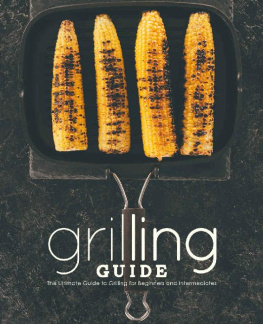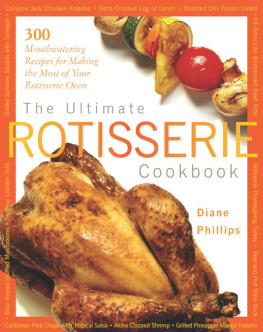THE ROTISSERIE GRILLING COOKBOOK
SUREFIRE RECIPES & FOOLPROOF TECHNIQUES
Derrick Riches & Sabrina Baksh

I NTRODUCTION
BASIC EQUIPMENT AND TECHNIQUES FOR ROTISSERIE GRILLING
In our twenty years of writing about barbecue and grilling, one of the most frequent questions we hear is, why the rotisserie? Almost all gas grills have a rotisserie option and many charcoal grills have rotisserie accessories available. Although these items are commonly available, many people are still hesitant to think of them as an important extension of their regular grilling practices. This is truly a shame.
Grills purchased straight from the showroom floor are perfect for cooking burgers, steaks, hot dogs, and kebabs, but when it comes to roasts and whole chickens, they often struggle. To properly grill a steak requires a high, direct heat. The steak sits over the fire. The surface browns and develops a crust quickly, while the interior can achieve any level of desired doneness. Steaks are relatively thin and cook fast. A large roast or whole chicken, on the other hand, requires slower roasting to achieve perfection. Cooked over high heat, these meats will char on the exterior before the center has a chance to reach an appropriate temperature.
To cook large pieces of meat requires indirect grilling coupled with low heat. Simply stated, indirect grilling is exactly what it sounds like: The heat is to the side of the food and not directly underneath. Depending on the size of the grill in question, this can be done relatively easily, but it will still require a lot of turning. Turning over. Turning around. Turning back. Lots of movement to achieve an even and complete cooking. The rotisserie, however, does all of the turning and so much more. It allows you to cook larger cuts of meat than you can by direct-heat grilling, but without as much fuss as indirect grilling requires.
A proper rotisserie rotates at a speed that keeps the juices from dripping excessively and allows them to roll around the surface of foods. This is why there are sometimes stripes running around rotisserie chickens or roasts. These natural juices baste the meat continually, which reduces drying and increases flavor.
The constant rotation also reduces the likelihood of burning. No one side of the food is exposed to the heat long enough to cause charring. It gets hot and then moves on. This means that rotisserie cooking is faster and easier than simply placing large cuts of meat on the cooking grates. It requires less monitoring and a shorter cooking time because the grill can be operated at a higher temperature. What results is an evenly cooked roast, whole bird, or whatever main or side dish you choose to prepare.
While food on a rotisserie is self-basted, the constant turning motion makes it easier to add an extra baste as it cooks. This means flavors can be layered throughout the grilling process without having to pick up a pair of tongs or doing much more than simply lifting the lid and painting on a baste. And because the baste stays on the food as it turns, less is needed and the food absorbs more of its flavor.
G RILL T YPES : G AS VERSUS I NFRARED VERSUS C HARCOAL
Most large grills can do rotisserie cooking. At its most basic level, it is simply a dry roasting method of cooking. The difference is that the food is suspended and is in constant motion. The process is not all that dissimilar from placing a roast or chicken on a rack in the oven to cook. Out on the grill, the roasting environment is drier, which is optimal, because a wet roasting method reduces the browning on the surface; the dry environment is what gives us the crusty surface or bite through skin that we are looking for. It is this dry, hot environment that is best for roasting.
The type of grill being used will also make a difference. Gas grills are more convenient, while charcoal grills produce a more authentic, smoky flavor. Charcoal grills have the driest cooking environment and propane grills the wettest, though by wet we are talking about a relative amount of moisture.










